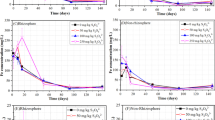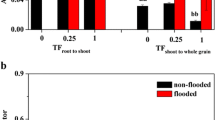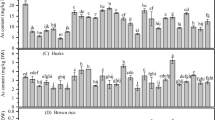Abstract
Purpose
Nitrogen is widely used in agricultural production, including in arsenic-contaminated soil. However, there is a lack of systematic studies on the arsenic (As) dynamics in soil porewater–root surface–rice system after applying different nitrogen fertilizers to As-contaminated soil.
Materials and methods
Three treatments (CK, Nitrate-N, and Ammonium-N) were applied before rice planting to investigate the effect of nitrogen forms on arsenic accumulation in brown rice and its dynamics in soil-plant system.
Results and discussion
Compared to Nitrate-N and CK treatments, Ammonium-N treatment increased rice biomass and yield. Compared with CK treatment (0.12 and 4.48 mg/kg), Ammonium-N treatment (0.08 and 2.71 mg/kg) reduced the As concentrations and Nitrate-N treatment (0.18 and 6.20 mg/kg) increased the As concentrations in brown rice and shoots. Nitrogen application reduced Fe plaques concentration on roots, but Ammonium-N treatment increased the total As accumulation in Fe plaques. In soil porewater, Nitrate-N treatment reduced the concentration of As (III) in the first month (5.2–47.0 μg/L) but increased its concentration in the last month (137.6–183.1 μg/L). However, the concentration of As (III) in Ammonium-N treatment (58.5–168.6 μg/L) was similar to that in CK treatment (72.8–138.8 μg/L) in porewater.
Conclusions
The application of Nitrate-N caused the decrease of As in porewater during the seedling stage; however, the As concentration in rice grains was increased due to the increase of As (III) in porewater during the ripening stage. The application of Ammonium-N reduced the As concentration in rice tissues by increasing biomass and accumulating more As in Fe plaques.





Similar content being viewed by others
References
Abiko T, Obara M (2014) Enhancement of porosity and aerenchyma formation in nitrogen-deficient rice roots. Plant Sci 215-216:76–83. https://doi.org/10.1016/j.plantsci.2013.10.016
Britto DT, Siddiqi MY, Glass ADM (2001) Futile transmembrane NH4+ cycling: a cellular hypothesis to explain ammonium toxicity in plants. P Natl Acad Sci USA 98:4255–4258. https://doi.org/10.1073/pnas.061034698
Cai LM, Xu ZC, Qi JY, Feng ZZ, Xiang TS (2015) Assessment of exposure to heavy metals and health risks among residents near Tonglushan mine in Hubei, China. Chemosphere 127:127–135. https://doi.org/10.1016/j.chemosphere.2015.01.027
Carlson HK, Clark IC, Blazewicz SJ, Iavarone AT, Coates JD (2015) Fe(II) oxidation is an innate capability of nitrate-reducing bacteria that involves abiotic and biotic reactions. J Bacteriol 195:3260–3268. https://doi.org/10.1128/JB.00058-13
Chen XP, Zhu YG, Hong MN, Kappler A, Xu YX (2008) Effects of different forms of nitrogen fertilizers on arsenic uptake by rice plants. Environ Toxicol Chem 27:881–887. https://doi.org/10.1897/07-368.1
Clément JC, Shrestha J, Ehrenfeld JG, Jaffe PR (2005) Ammonium oxidation coupled to dissimilatory reduction of iron under anaerobic conditions in wetland soils. Soil Biol Biochem 37:2323–2328. https://doi.org/10.1016/j.soilbio.2005.03.027
Colmer TD, Bloom AJ (1998) A comparison of NH4+ and NO3– net fluxes along roots of rice and maize. Plant Cell Environ 21:240–246. https://doi.org/10.1046/j.1365-3040.1998.00261.x
Corsini A, Cavalca L, Crippa L, Zaccheo P, Andreoni V (2010) Impact of glucose on microbial community of a soil containing pyrite cinders: role of bacteria in arsenic mobilization under submerged condition. Soil Biol Biochem 42:699–707. https://doi.org/10.1016/j.soilbio.2009.12.010
Ding LJ, An XL, Li S, Zhang GL, Zhu YG (2014) Nitrogen loss through anaerobic ammonium oxidation coupled to iron reduction from paddy soils in a chronosequence. Environ Sci Technol 48(18):10641–10647. https://doi.org/10.1021/es503113s
Gibney BP, Nüsslein K (2007) Arsenic sequestration by nitrate respiring microbial communities in urban lake sediments. Chemosphere 70:329–336. https://doi.org/10.1016/j.chemosphere.2007.05.094
He CJ, Drew MC, Morgan PW (1994) Induction of enzymes associated with lysigenous aerenchyma formation in roots of Zea mays during hypoxia or nitrogen starvation. Plant Physiol 105:861–865. https://doi.org/10.1104/pp.105.3.861
Hoeft SE, Lucas F, Hollibaugh JT, Oremland RS (2002) Characterization of microbial arsenate reduction in the anoxic bottom waters of Mono Lake, California. Geomicrobiol J 19:23–40. https://doi.org/10.1080/014904502317246147
Jamieson J, Prommer H, Kaksonen AH, Sun J, Siade AJ, Yusov A, Bostick B (2018) Identifying and quantifying the intermediate processes during nitrate-dependent iron (II) oxidation. Environ Sci Technol 52:5771–5781. https://doi.org/10.1021/acs.est.8b01122
Jiang FY, Chen X, Luo AC (2009) Iron plaque formation on wetland plants and its influence on phosphorus, calcium and metal uptake. Aquat Ecol 43:879–890. https://doi.org/10.1007/s10452-009-9241-z
King GM, Garey MA (1999) Ferric iron reduction by bacteria associated with the roots of freshwater and marine macrophytes. Appl Environ Microbiol 65:4393–4398. https://doi.org/10.1111/j.1708-8240.2011.00425.x
Kumarathilaka P, Seneweera S, Ok YS, Meharg A, Bundschuh J (2019) Arsenic in cooked rice foods: assessing health risks and mitigation options. Environ Int 127:584–591. https://doi.org/10.1016/j.envint.2019.04.004
Lee CH, Hsieh YC, Lin TH, Lee DY (2013) Iron plaque formation and its effect on arsenic uptake by different genotypes of paddy rice. Plant Soil 363:231–241. https://doi.org/10.1007/s11104-012-1308-2
Li CY, Carrijo DR, Nakayama Y, Linquist BA, Green PG, Parikha SJ (2019) Impact of alternate wetting and drying irrigation on arsenic uptake and speciation in flooded rice systems. Agr Ecosyst Environ 272:188–198
Liang Y, Zhu YG, Xia Y, Ma Y (2006) Iron plaque enhances phosphorus uptake by rice (Oryza sativa) growing under varying phosphorus and iron concentrations. Ann Appl Biol 149:305–312. https://doi.org/10.1111/j.1744-7348.2006.00095.x
Lin Z, Wang X, Wu X, Liu D, Yin Y, Zhang Y, Xiao S, Xing B (2018) Nitrate reduced arsenic redox transformation and transfer in flooded paddy soil-rice system. Environ Pollut 243:1015–1025. https://doi.org/10.1016/j.envpol.2018.09.054
Limmer MA, Seyfferth AL (2020) The role of small molecules in restricting rice accumulation of dimethylarsinic acid. Plant Soil 447:599–609. https://doi.org/10.1007/s11104-019-04414-1
Liu C, Yu H, Liu C, Li F, Xu X, Wang Q (2015) Arsenic availability in rice from a mining area: is amorphous iron oxide-bound arsenic a source or sink? Environ Pollut 199:95–101. https://doi.org/10.1016/j.envpol.2015.01.025
Liu J, Qian M, Cai G, Zhu Q, Wong M (2007) Variations between rice cultivars in root secretion of organic acids and the relationship with plant cadmium uptake. Environ Geochem Hlth 29:189–195. https://doi.org/10.1007/s10653-006-9063-z
Matsumoto S, Kasuga J, Makino T, Arao T (2016) Evaluation of the effects of application of iron materials on the accumulation and speciation of arsenic in rice brown rice grown on uncontaminated soil with relatively high levels of arsenic. Environ Exp Bot 125:42–51. https://doi.org/10.1016/j.envexpbot.2016.02.002
Melton ED, Schmidt C, Kappler A (2012) Microbial iron(II) oxidation in littoral freshwater lake sediment: the potential for competition between phototrophic vs. nitrate-reducing iron(II)-oxidizers. Front Microbiol 3:197. https://doi.org/10.3389/fmicb.2012.00197
Mkandawire M, Dudel EG (2005) Accumulation of arsenic in Lemna gibba L. (duckweed) in tailing waters of two abandoned uranium mining sites in Saxony, Germany. Sci Total Environ 336:81–89. https://doi.org/10.1016/j.scitotenv.2004.06.002
Neubauer SC, Toledo-Durán GE, Emerson D, Megonigal JP (2007) Returning to their roots: iron-oxidizing bacteria enhance short-term plaque formation in the wetland-plant rhizosphere. Geomicrobiol J 24:65–73. https://doi.org/10.1080/01490450601134309
Onken BM, Adriano DC (1997) Arsenic Availability in Soil with Time under Saturated and Subsaturated Conditions. Soil Sci Soc Am J 61:746–752. https://doi.org/10.2136/sssaj1997.03615995006100030007x
Oremland RS, Hoeft SE, Santini JA, Bano N, Hollibaugh RA, Hollibaugh JT (2002) Anaerobic oxidation of arsenite in Mono Lake water and by a facultative, arsenite-oxidizing chemoautotroph, strain MLHE-1. Appl Environ Microbiol 68:4795–4802. https://doi.org/10.1128/AEM.68.10.4795-4802.2002
Rahman MA, Hasegawa H, Rahman MM, Maki T, Lim RP (2013) Effect of iron (Fe2+) concentration in soil on arsenic uptake in rice plant (Oryza sativa L.) when grown with arsenate [As(V)] and dimethylarsinate (DMA). Water Air Soil Pollut 224:1–11. https://doi.org/10.1007/s11270-013-1623-0
Rakshit S, Matocha CJ, Coyne MS, Sarkar D (2016) Nitrite reduction by Fe(II) associated with kaolinite. Int J Environ Sci Tech 13:1329–1334. https://doi.org/10.1007/s13762-016-0971-x
Pedersen HD, Postma D, Jakobsen R (2006) Release of arsenic associated with the reduction and transformation of iron oxides. Geochim Cosmochim Ac 70:4116–4129. https://doi.org/10.1016/j.gca.2006.06.1370
Shi T, Liu H, Wang J, Chen Y, Fei T, Wu G (2014) Monitoring arsenic contamination in agricultural soils with reflectance spectroscopy of rice plants. Environ Sci Technol 48:6264–6272. https://doi.org/10.1021/es405361n
Srivastava S, Pathare VS, Sounderajan S, Suprasanna P (2019) Nitrogen supply influences arsenic accumulation and stress responses of rice (Oryza sativa L.) seedlings. J Hazard Mater 367:599–606. https://doi.org/10.1016/j.jhazmat.2018.12.121
Syu CH, Jiang PY, Huang HH, Chen WT, Lin TH, Lee DY (2013) Arsenic sequestration in iron plaque and its effect on As uptake by rice plants grown in paddy soils with high contents of As, iron oxides, and organic matter. Soil Sci Plant Nutr 59:463–471. https://doi.org/10.1080/00380768.2013.784950
Ultra VU, Nakayama A, Tanaka S, Kang Y, Sakurai K, Iwasaki K (2009) Potential for the alleviation of arsenic toxicity in paddy rice using amorphous iron-(hydr) oxide amendments. Soil Sci Plant Nutr 55:160–169. https://doi.org/10.1111/j.1747-0765.2008.00341.x
Wang X, Liu T, Li F, Li B, Liu (2018) Effects of simultaneous application of ferrous iron and nitrate on arsenic accumulation in rice grown in contaminated paddy soil. ACS Earth Space Chem 2:103–111. https://doi.org/10.1021/acsearthspacechem.7b00115
Williams PN, Lei M, Sun G, Huang Q, Lu Y, Deacon C, Meharg AA, Zhu Y (2009) Occurrence and partitioning of cadmium, arsenic and lead in mine impacted paddy rice: Hunan, China. Environ Sci Technol 43:637–642. https://doi.org/10.1021/es802412r
Wilson SC, Lockwood PV, Ashley PM, Tighe M (2010) The chemistry and behaviour of antimony in the soil environment with comparisons to arsenic: a critical review. Environ Pollut 158:1169–1181. https://doi.org/10.1016/j.envpol.2009.10.045
Wu C, Ye Z, Li H, Wu S, Deng D, Zhu Y, Wong M (2012) Do radial oxygen loss and external aeration affect iron plaque formation and arsenic accumulation and speciation in rice? J Exp Bot 63:2961–2970. https://doi.org/10.1093/jxb/ers017
Wu D, Wei Z, Well R, Shan J, Yan X, Bol R, Senbayram M (2018) Straw amendment with Nitrate-N decreased N2O/(N2O+N2) ratio but increased soil N2O emission: a case study of direct soil-born N2 measurements. Soil Biol Biochem 127:301–304. https://doi.org/10.1016/j.soilbio.2018.10.002
Yang Y, Hu H, Fu Q, Zhu J, Huang G (2019a) Water management of alternate wetting and drying reduces the accumulation of arsenic in brown rice rice-as dynamic study from rhizosphere soil to rice. Ecotox Environ Safe 185:109711.1–109711.8. https://doi.org/10.1016/j.ecoenv.2019.109711
Yang Y, Hu H, Fu Q, Xing Z, Chen X, Zhu J (2019b) Comparative effects on arsenic uptake between iron (hydro)oxides on root surface and rhizosphere of rice in an alkaline paddy soil. Environ Sci Pollut R 27:6995–7004. https://doi.org/10.1007/s11356-019-07401-2
Yang Y, Hu H, Fu Q, Zhu J, Zhang X, Xi R (2020) Phosphorus regulates As uptake by rice via releasing As into soil porewater and sequestrating it on Fe plaque. Sci Total Environ 738:139869. https://doi.org/10.1016/j.scitotenv.2020.139869
Zhao FJ, Wang P (2020) Arsenic and cadmium accumulation in rice and mitigation strategies. Plant Soil 14:1–21. https://doi.org/10.1007/s11783-019-1203-7
Zhang C, Ying GE, Yao H, Chen X, Minku HU (2012) Iron oxidation-reduction and its impacts on cadmium bioavailability in paddy soils: a review. Fron Env Sci Eng 6:509–517. https://doi.org/10.1007/s11783-012-0394-y
Zhang J, Zhao S, Xu Y, Zhou W, Huang K, Tang Z, Zhao F (2017) Nitrate stimulates anaerobic microbial arsenite oxidation in paddy soils. Environ Sci Technol 51:4377–4386. https://doi.org/10.1021/acs.est.6b06255
Zhang J, Zhou W, Liu B, He J, Shen Q, Zhao F (2015) Anaerobic arsenite oxidation by an autotrophic arsenite-oxidizing bacterium from an arsenic-contaminated paddy soil. Environ Sci Technol 49:5956–5964. https://doi.org/10.1021/es506097c
Zhang X, Zhang F, Mao D (1999) Effect of iron plaque outside roots on nutrient uptake by rice (Oryza sativa L.): phosphorus uptake. Plant Soil 202:33–39. https://doi.org/10.1023/A:1004322130940
Zheng Q, Hou J, Hartley W, Ren L, Tan W (2020) As(III) adsorption on Fe-Mn binary oxides: are Fe and Mn oxides synergistic or antagonistic for arsenic removal? Chem Eng J 389:124470. https://doi.org/10.1016/j.cej.2020.124470
Acknowledgements
We thank Xiongfei Rao (Tobacco Research Institute of Hubei Province, Wuhan, China) for checking and editing the manuscript.
Funding
This work was supported by the National Natural Science Foundation of China (41771270) and the National Key Research and Development Program of China (2016YFD0800805).
Author information
Authors and Affiliations
Corresponding author
Ethics declarations
Conflict of interest
The authors declare no competing interests.
Additional information
Responsible editor: Hang-Wei Hu
Publisher’s note
Springer Nature remains neutral with regard to jurisdictional claims in published maps and institutional affiliations.
Highlights
(1) As concentration in brown rice was 48.8% lower in Ammonium-N than Nitrate-N treatments.
(2) Nitrate-N only reduced the As (III) concentration in porewater during seedling stage.
(3) Nitrate-N increased the exposure risk of As to roots during ripening stage.
(4) Ammonium increased biomass of rice, diluted the As concentration in brown rice.
Supplementary Information
ESM 1
(DOCX 103 kb)
Rights and permissions
About this article
Cite this article
Zhang, X., Yang, Y., Fu, Q. et al. Comparing effects of ammonium and nitrate nitrogen on arsenic accumulation in brown rice and its dynamics in soil-plant system. J Soils Sediments 21, 2650–2658 (2021). https://doi.org/10.1007/s11368-021-02938-7
Received:
Accepted:
Published:
Issue Date:
DOI: https://doi.org/10.1007/s11368-021-02938-7




